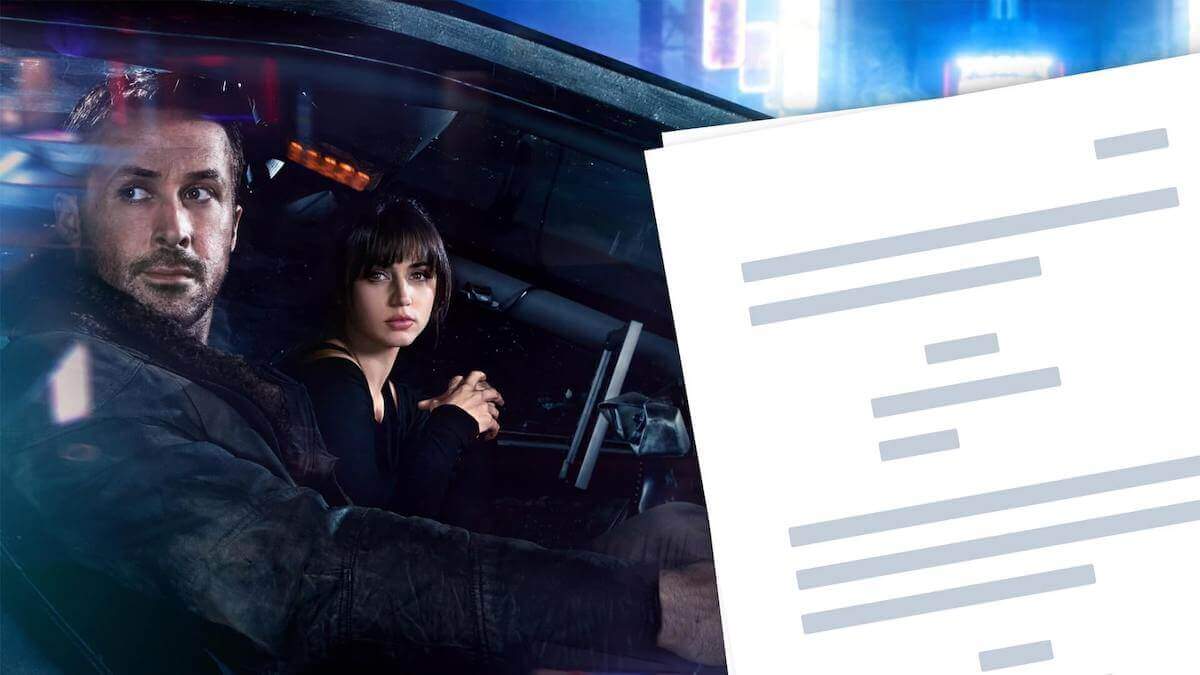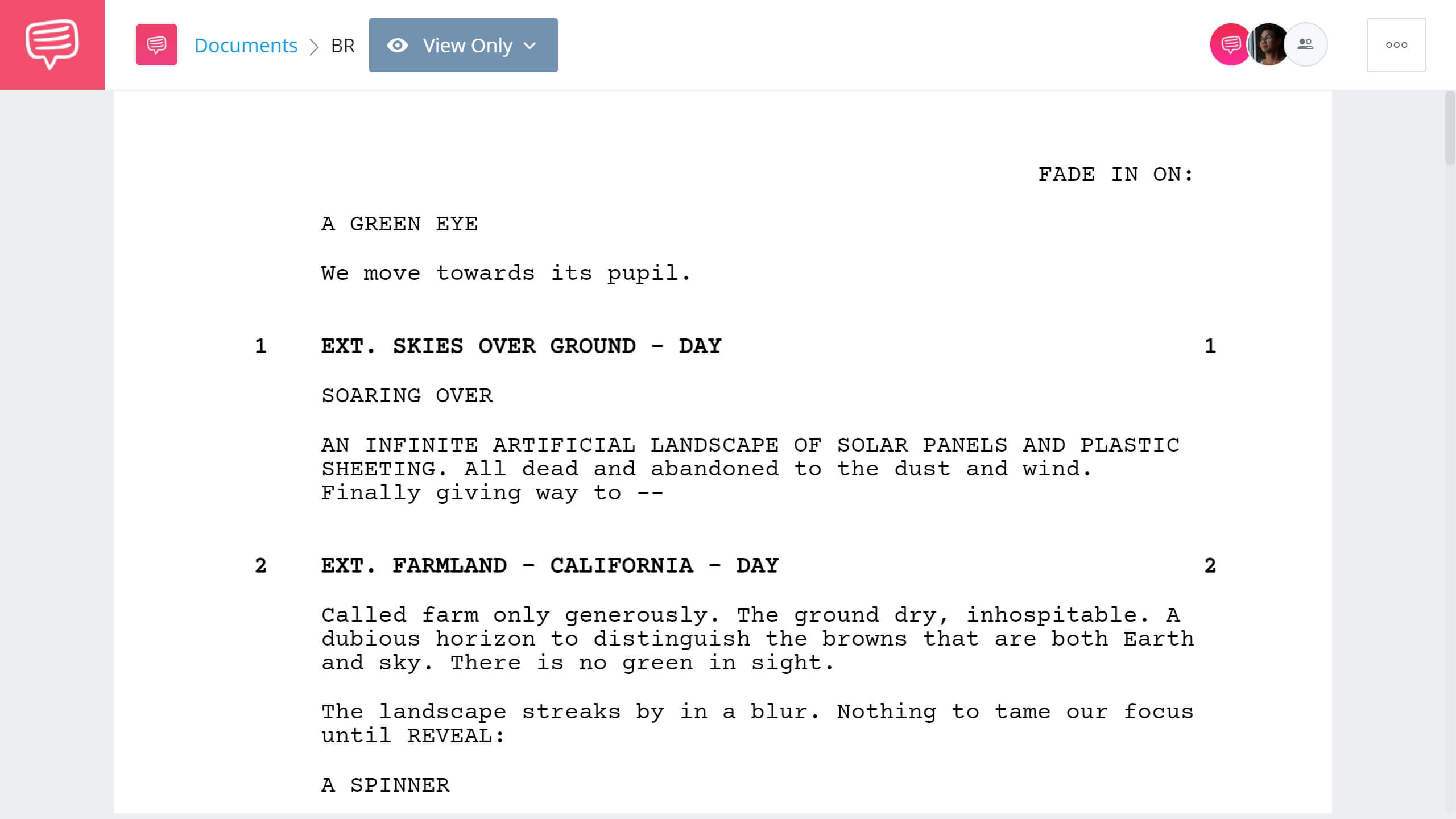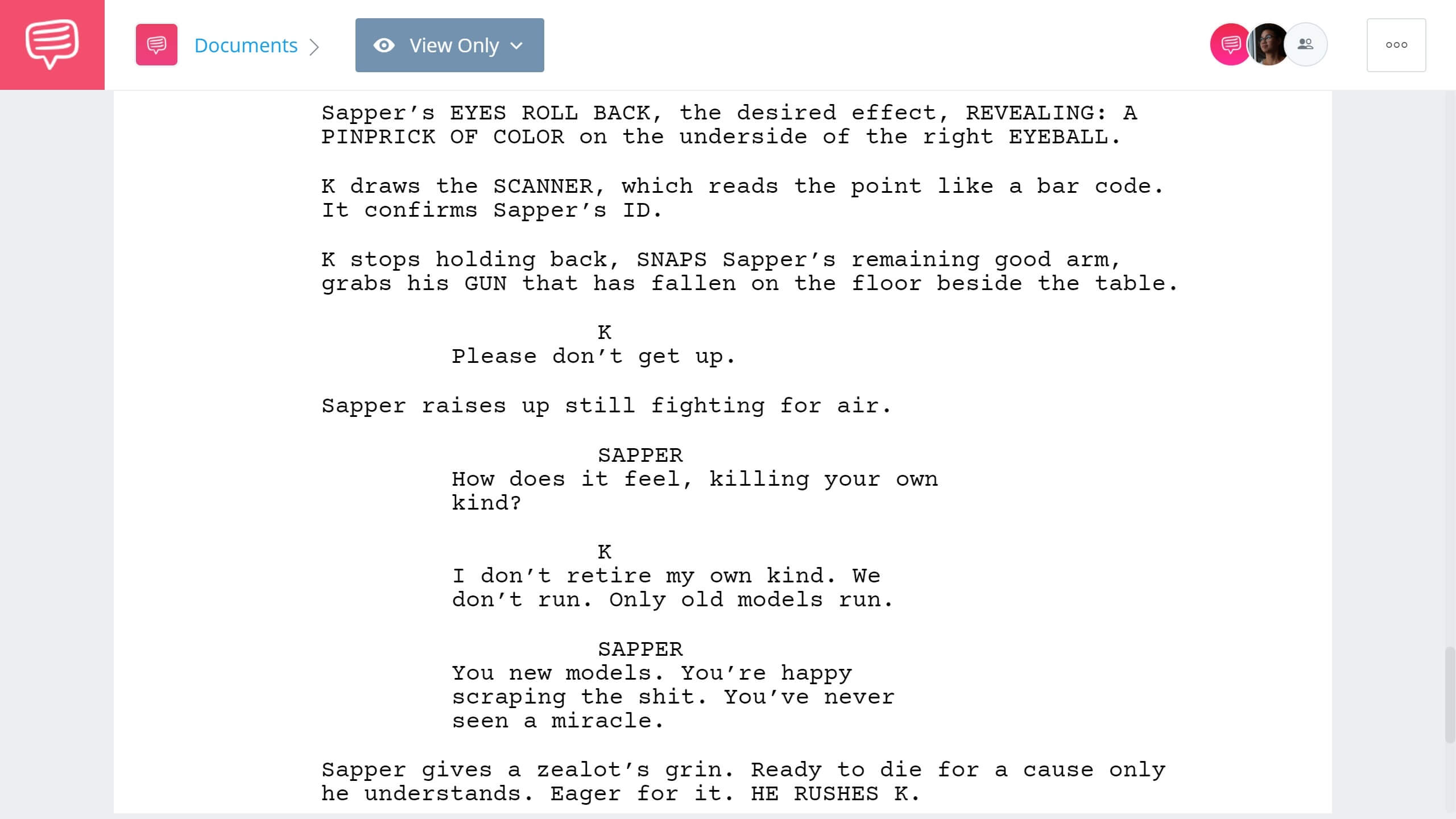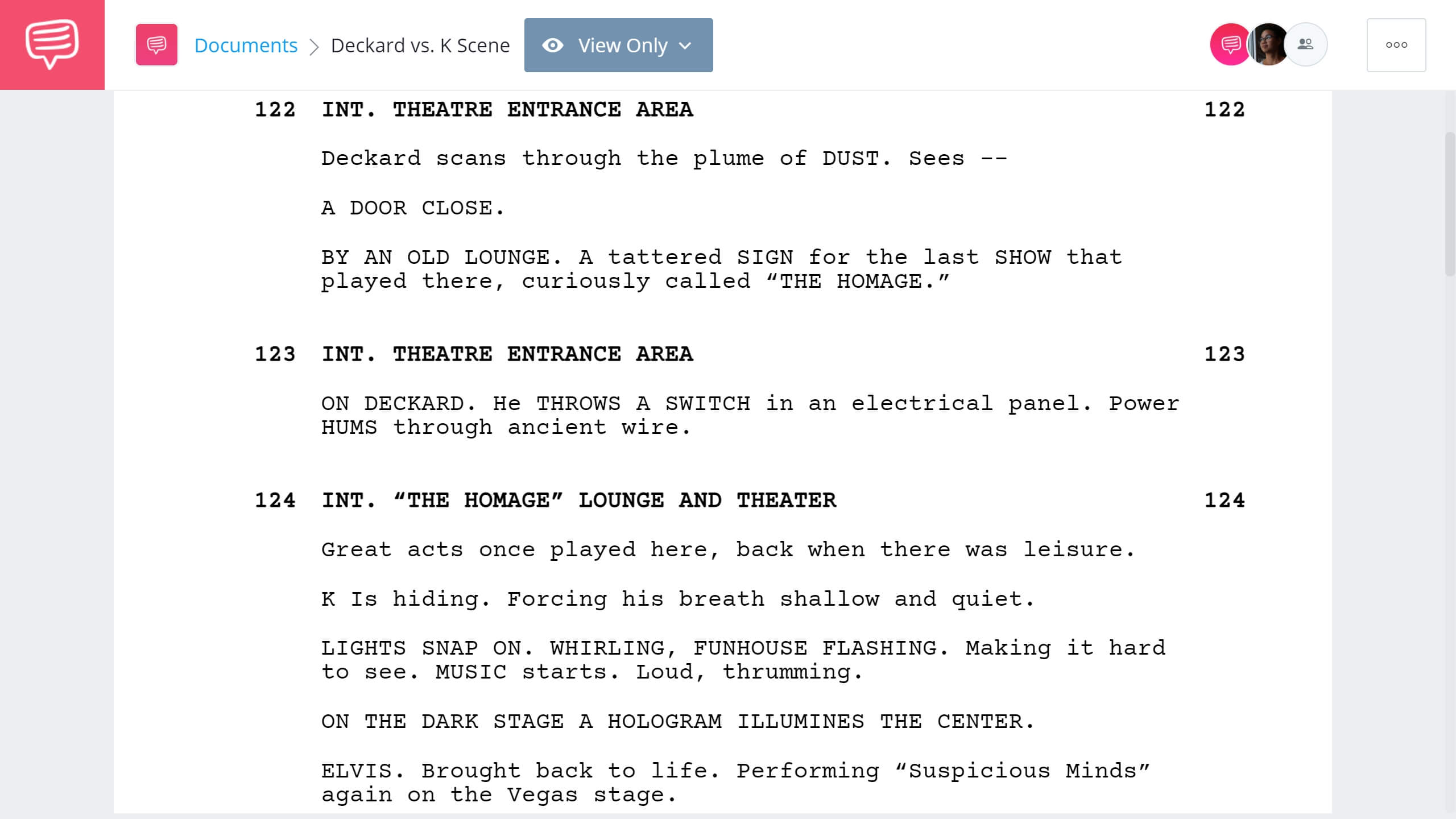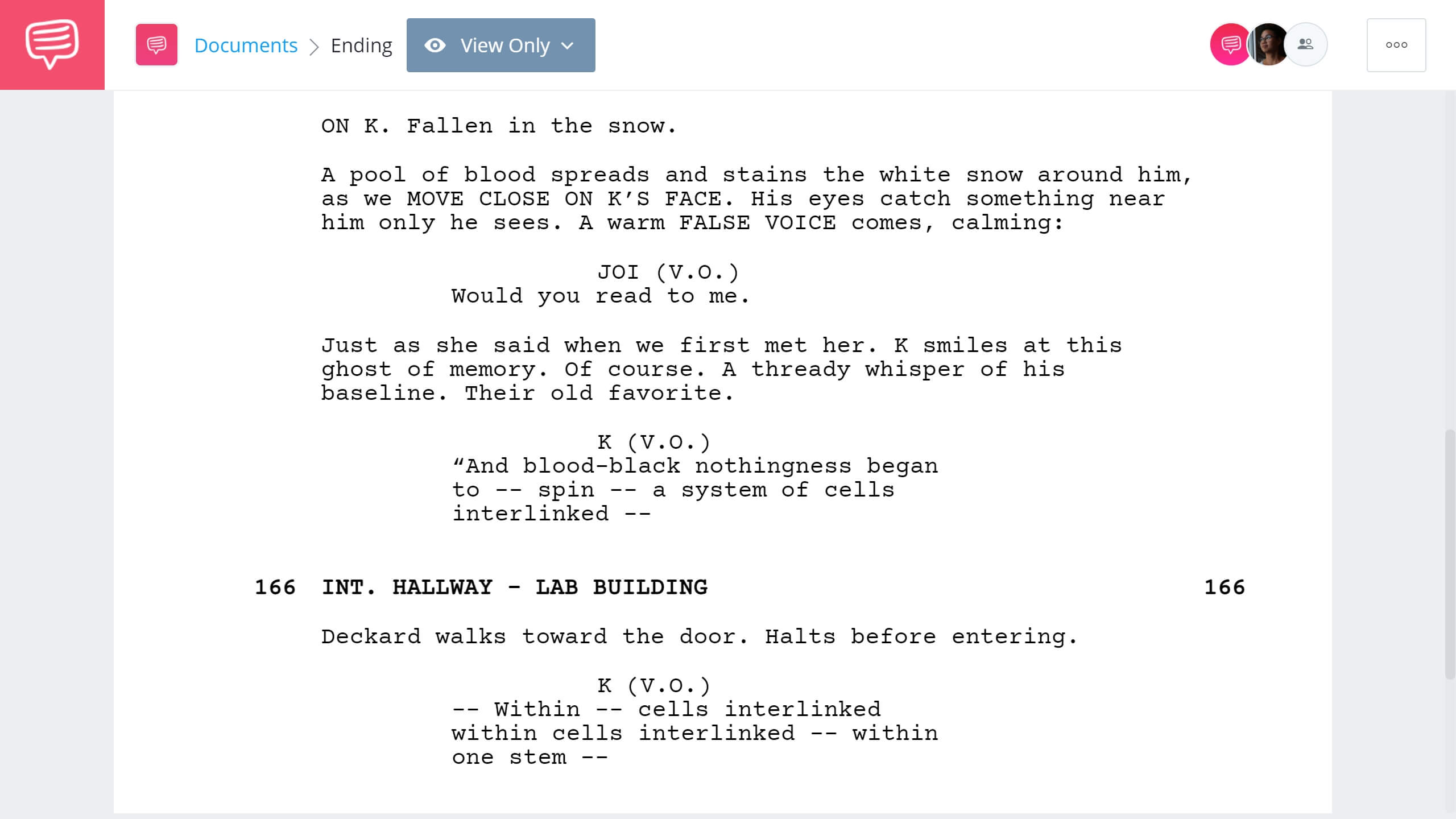Blade Runner 2049 breathed new life into Ridley Scott’s world of replicants and blade runners due to its great performances, steady direction, and bold cinematography. But all of the visual splendor that we see in the final cut, was once just words on a page. The Blade Runner 2049 script set the stage for a sequel that was even better than the original. We’re going to explore why the script is so good by looking at its structure, fight scenes and ending. But before we get into our analysis, download a Blade Runner 2049 script PDF below and read along!


WHO WROTE THE BLADE RUNNER 2049 SCRIPT?
Written by Hampton Fancher and Michael Green
Hampton Fancher is an American screenwriter, actor, producer and director, who is perhaps most well-known for pursuing the optioning of Philip K. Dick’s Do Androids Dream of Electric Sheep? and writing Blade Runner.
Michael Green is an American writer and producer who has worked in film and television since 1998. Some of his most famous credits include writing for Sex and the City and Logan, as well as writing and executive-producing Heroes.
STORY BREAKDOWN
STRUCTURE OF THE BLADE RUNNER 2049 SCREENPLAY
Here is the story structure for the Blade Runner 2049 screenplay:
Blade Runner 2049 Opening Text & Exposition
An LAPD officer (K) “retires” an outdated “replicant” who went AWOL from his post. Before K leaves, he discovers a farm gravesite and orders an excavation squad to investigate.
Inciting Incident
K uses the proceeds from his bonus to buy an emanator so that he can expand the functionality of his AI girlfriend JOI. But K is called back into work before he’s able to spend time with her and is told that the gravesite at the farm contained the bones of a woman who died in childbirth.
Plot Point One
K is told that he must find and “retire” the child of the replicant. His investigation starts at Wallace headquarters — the former Tyrell Corporation — where he meets a young replicant woman named Luv, who subtly suggests that a former police officer named Deckard may be involved.
Plot Point One: Part Two
Niander Wallace instructs Luv to find the missing “child” so that he can understand how Tyrell gave replicants the ability to procreate. K goes back to the farm and discovers the grave was marked with a date, 28 years prior to the current day.
Rising Action
K recalls an implanted memory of a “wooden horse figure” that coincides with the exact date he found on the grave marker. After he finds the wooden horse figurine to be real, he begins to suspect that he may be the missing child that he’s supposed to be hunting.
Midpoint
K meets with Dr. Ana Stelline, a memory builder who tells him that his memory of the wooden horse figurine is real, not created. In response to this new information, K fails his baseline test.
Plot Point Two
K travels to the remnants of Las Vegas to pursue a lead on the figurine — where he finds former blade runner Rick Deckard.
Build Up
Deckard reveals that he had to give “the child” up because he was being hunted. Luv goes to Las Vegas, destroys Joi, captures Deckard and brings him to meet Wallace.
Climax
Wallace decides to send Deckard off-planet to torture him into revealing how the child was born. But before his “spinner” is able to leave Earth, it’s attacked by K.
Finale
A battle ensues. K kills Luv but is mortally wounded in the fight. He frees Deckard and guides him to Dr. Ana Stelline’s memory center.
Denouement
K lays on the steps in front of Ana’s building slowly bleeding out. Deckard goes inside and meets his daughter for the very first time.
For more, explore an exciting collection of sci-fi movie scripts in our dedicated series. Dive in now to discover a world of captivating science fiction stories!
Blade Runner 2049 Script Takeaway #1
Blade Runner 2049 plot is limitless
Blade Runner 2049 may be most famous for its visual grandeur, but the script is genuinely terrific as well. But why is it so good? Well, it starts with excellent screenplay formatting (I know it sounds boring) — but too often do we see screenplays that take a disjointed approach to formatting.
By properly adhering to “industry standard” screenplay format, writers Hampton Fancher and Michael Green filled the story with expressive detail and visceral actions — all delivered in a clear and concise way.
We imported the Blade Runner 2049 screenplay into StudioBinder’s screenwriting software to take a closer look at how Fancher and Green utilize the strengths of script format. As you’re reading this opening scene, pay attention to how the writers create story flow and capitalize certain actions to emphasize their importance.
The purpose of a shooting script is to create a blueprint for the film’s production. This scene perfectly exemplifies everything a shooting script should be. Important actions are written in caps, like “THE DOOR OPENS;” important props are written in caps and underlined, like “a single wriggling WORM.” This tells the production team and the actors what they should pay attention to.
Shooting scripts also tell us how a scene should be shot, like “REVEAL: Sapper has A SCALPEL from his satchel” and how it should be relayed, like “HOLD ON THE GUN. So we only HEAR Sapper’s body DROP.”
Now let’s see how director Denis Villeneuve shot this scene just as it was written in the script.
Blade Runner 2049 Plot ‘Opening Scene’
As you can see, the final cut of the film matches the script’s actions and dialogue to a tee. Not every film follows the script as close as Blade Runner 2049 does, but when it’s done well, it can create the impression of a cohesive vision from start to finish.
Blade Runner 2049 Script Takeaway #2
Blade Runner 2049 fight scene is perfect
It can be incredibly difficult to learn how to write a fight scene. Many writers struggle with communicating sporadic action, interweaving dialogue, and parsing down the combat — but when writers stick to what works, fight scenes often evoke a visceral reaction in the audience.
So how do you write a fight scene? Well, it just so happens that the Blade Runner 2049 script shows us how to do it effectively. Follow along as we look at the fight scene between K and Deckard — and think about how you would emphasize action in the combat.
Blade Runner 2049 Characters in Conflict • Read the ‘Deckard v. K’ Scene
In order to understand why this fight scene works so well, we need to cover the foundational aspects of fight scenes. Every fight scene needs three things: conflict, action and resolution. Let’s look at how Blade Runner 2049 addresses these three foundational necessities.
- Conflict: K v. Decker
- Action: Hand to hand combat, weapon props and stealth.
- Resolution: Decker concedes to K and they agree to talk it out.
It’s remarkably simple, but nevertheless effective. This scene from the Blade Runner 2049 screenplay doesn’t just cover the basics though — it expands upon them with exaggeration and specificity. To see these tenets put into action, let’s watch the scene from the movie below.
Blade Runner 2049 Characters in Conflict • Blade Runner 2049 Fight Scene
The music and holograms add a strong sense of artificiality to the scene — and more importantly, it makes the scene feel unique. Think about if Deckard and K fought on the second floor balcony where the scene started; it just wouldn’t be the same.
It would’ve been more subdued, less expressive and generally bland. By staging the fight in a changing environment, the writers created a frenetic pace — and of course Villeneuve and cinematographer Roger Deakins added some masterclass visual flair.
Blade Runner 2049 Script Takeaway #3
Blade Runner 2049 ending is satisfying
Want to learn how to write a satisfying denouement? Look no further than Blade Runner 2049. Many screenwriters argue that the two most important scenes in a script are the beginning and end. The beginning establishes the plot and the ending gives resolution to it.
We’ve already talked about why the opening scene of Blade Runner 2049 is a success, so let’s take a look at what makes the ending work too.
In this denouement, the theme of “autonomous capability” is resolved. K concedes that his memories were never his own and succumbs to the reality of the situation. As you read, think about how the writers used symbolism to communicate something profound.
Blade Runner 2049 Screenplay • Read the ‘Ending’ Scene
In the script, K bleeds out on the steps while reciting his “baseline test” from earlier. I’d say that’s a good ending. It gives resolution to his character and completes the story arc in a clear and insightful way.
But this scene plays out a little bit differently in the movie. Watch the clip below and pay special attention to the music.
Blade Runner 2049 Ending Scene
If you’ve seen the original Blade Runner, you might recognize the musical theme called “Tears in Rain.” If you’re unfamiliar or want to review the theme, check out the clip below.
Blade Runner Ending Scene
Since the endings of Blade Runner and Blade Runner 2049 both address similar themes, we can say that the double-use of “Tears in Rain” is a musical motif. And it doesn’t just resolve the story arc of 2049, it creates a narrative thread that implicitly connects both films.
Related Posts
UP NEXT
Read and download more scripts
The Blade Runner 2049 script is a masterful example of how to write a sci-fi sequel. If you want to continue reading screenplays, we have similar titles like Star Wars, The Usual Suspects, and No Country For Old Man in our screenplay database. Browse and download PDFs for all of our scripts as you read, write and practice your craft to become the next great screenwriter.
